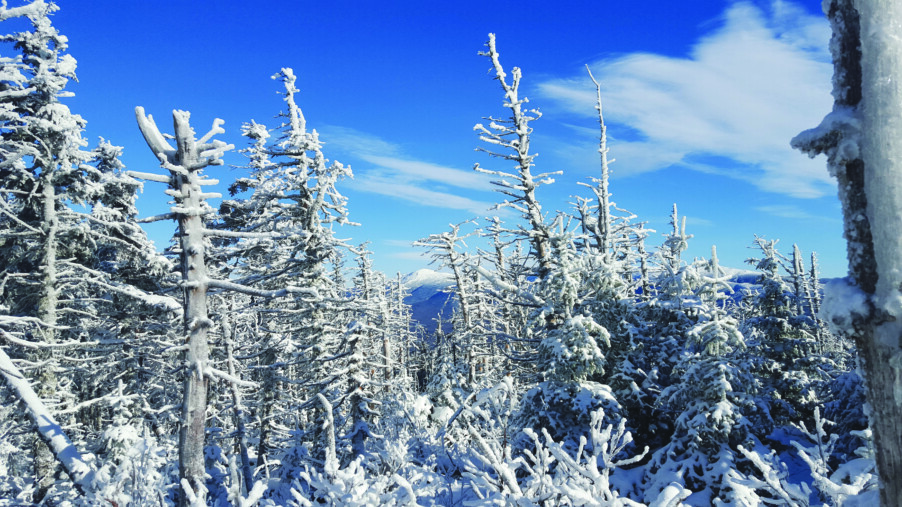Advice on hiking during the coldest season
PLUS Winter birds and where to find them
By Zachary Lewis
zlewis@hippopress.com
Outdoor enthusiasts don’t let snow or single-digit temperatures stop them from getting out there. Looking to hike (or take a woodland walk) in the winter? Here is some advice from the experts.
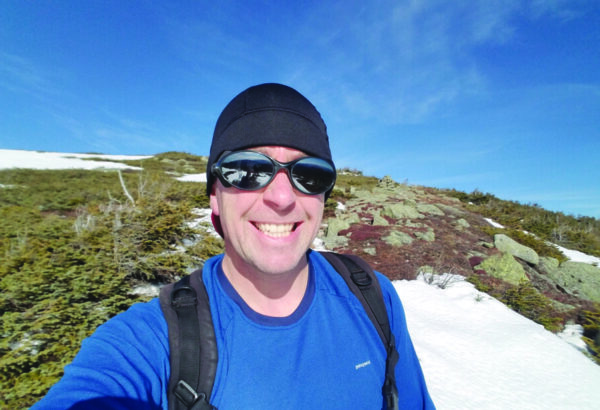
Hitting the snowy trail
Matt Larson has hiked all 48 and wrote a book about it called 4000s by 40, which came out in September.
“I had this mission before I turned 40 to climb all the 4,000-footers,” he said. His book can be found on wanderingmattlarson.com. These mountains loomed before Larson.
“I grew up in Massachusetts and I always loved it when we came over to New Hampshire and went skiing in the North Country or were in the Lakes region. I was always very aware of the mountains. They earned a spot in my heart from a very young age,” he said.
As a Granite Stater Larson had the perfect opportunity to accomplish his goal.
“I live in the southern part of the state now. I was so excited when that happened because I finally got to be close to all these mountains that I always loved as a kid. When I was coming close to turning 40, I realized that I really hadn’t explored all of the mountains that I wanted to. I climbed a few of them, but I just felt like this deep connection with the 4,000-footers. It just felt a shame to me that I hadn’t really fully explored them yet. That was my first call to arms, so to speak, for getting out on the trail,” he said. He started in the winter because his birthday is in February and gave himself a timeline for the year.
“I started off hiking in the snow and quickly learned that I needed microspikes the first time I went climbing in the winter. I did not have them and had to learn about the proper gear that was really necessary to take on the mountains during the wintertime and learned a lot fast. I’ve been doing it for quite a while now,” Larson said.
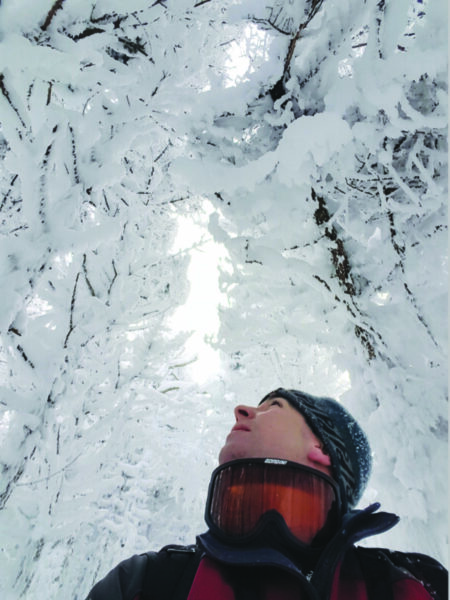
Larson was persistent even as his dream met with reality.
“I had big visions when I first started off, and so I thought I was going to be able to climb two mountains in one day in the middle of winter without microspikes. I went up East Osceola and I was hoping to climb over what’s called the chimney from there to Mount Osceola. About halfway up, I thought I had something called Yaktrax in my bag so I thought I had something to help me with the ice. I didn’t have spikes yet, but I at least thought I had my Yaktrax with me. I went into my bag to take them out and realized I had left them in the car. So without anything to help me, I really was contemplating turning around. I ended up actually finding a way through. Along the sides of the trail, there’s a bunch of thickets and narrowly spaced pines that you can grab onto so I was able to actually get to the top of East Osceola by navigating my way through the trees off the side of the trail, but I wasn’t going to shoot for the other peak of Mount Osceola, because it just was way too treacherous-looking.”
This close call led Larson to gear up.
“Shortly after that climb I went right out to my local EMS store … and I grabbed myself some microspikes,” he said
Most of his journeys were solo missions.
“That’s not to say I was alone out there. I mean, I was always really surprised. Even that first day in Osceola, I think I got to the parking lot at 6 in the morning and started climbing, and there was already somebody there who beat me to the lot,” he recalled. “It’s really amazing. I think as time has gone on more and more people are getting into this and getting outdoors. When I completed the 4,000-footers, I think it was sort of a banner year for the AMC in terms of people that were submitting a claim for having finished the 4,000-footers.”
Larson is excited that more people are embracing hiking in the cold.
“It’s been really nice to see how many people are taking on the adventure but being sensible about it too. The most impressive climbers to me are the ones that are doing it in the winter because they really are a much more thoughtful bunch about how to prepare for it and be safe. There’s plenty of stories of people who have taken on unnecessary risk during the winter, but it’s all very doable if people take the sensible approach and mitigate the risk through proper gear and awareness of the terrain and the weather. You do see a lot of people out there, which is great,” he said.
As with a river, no hiker steps onto the same mountain twice.
“It definitely changes week to week too. Even this winter. We went up around the Mount Tom and Mount Willey area and there was a little bit of snow on the ground. Then the next week I went out with a buddy to Cannon and it felt like a blizzard had hit the place. Very quickly it went from not needing any spikes or anything really on our feet, or just needing spikes for like a little portion of the trail up Mount Willey, to needing spikes the entire time up Mount Cannon and us contemplating if we even needed snowshoes,” Larson said.
The snowy terrain has the possibility for change after change and it is important to be cautious while enjoying the spectacular beauty of nature.
“There’ll be times that you’re out there and you’re using snowshoes for 50 percent of the climb up and then you have to switch back and forth between spikes and snowshoes because it gets really icy in some sections and then it can get really deep in others,” he said. “Then there’s other times where it doesn’t look like it’s that icy or that snowy but the rock is so slick. There’s sort of a form of black ice on some of the granite. People slip. I slipped a couple of times even with spikes on. You can have some moments where your feet can get pulled out from under you. It’s definitely important not to rush, especially on the descent. It’s always more dangerous on the descent.”
One perk of winter hiking is the chance encounter with wildlife.
“When I’m in the 4,000-footers … I’ve seen some minks. I’ve seen plenty of gray jays out of Mount Tom, Mount Willey and Mount Field in particular. … and of course everything from chipmunks to squirrels, all the usual suspects.”
There’s always a chance some critter will dart right out toward you. “I think the funniest encounter I had with any animals was one time I was on the trail and it was super quiet. It was kind of spooky how quiet it was. I was kind of thinking there might be a bear around, and I started inching my way up the trail, looking every single direction I could. Just as I started getting comfortable, all of a sudden, all of these pheasants just emerged out of this bush in front of me. There were probably 30 or 40 of them, or quail, I guess. You’ll see them out there too. Then there’s some turkeys along the way and mostly birds, birds and squirrels,” he said.
Regardless of the locale, hiking a mountain trail in the winter is a joy that Larson hopes others in the Granite State can experience for themselves.
“I love winter hiking. I love hiking at any time … but winter hiking is very peaceful. There really is a serenity to winter hiking that I think is unique. I definitely encourage people to try it if they’re thinking about it. One of the reasons why I wanted to write 4,000s by 40 was because I feel like there’s a lot of stories out there about the dangers of the mountains. I think there is inherent risk in climbing, but I do think that it’s something that’s a venture that everybody can enjoy if they just take sensible steps, there’s no reason they shouldn’t be able to enjoy winter hiking, too,” Larson said.
Snowshoes and postholing
Sometimes using snowshoes is not just for your own benefit but for keeping the trail in good shape. They’re mainly used for traversing powdery or deep snow, to keep you from sinking.
The City of Concord’s online guide to local trails (concordnh.gov/1033/Trails) includes this note: “On fresh snow, please use showshoes. Bare-booting can cause post-holing, which is a potential hazard for trail users.” Post-holing is trail-speak for when your boot sinks deep into the snow and leaves a hole. Not only is post-holing no fun, but later, someone else’s boot, ski or snowshoe can get tripped up by that hole.
Even with snowshoes, you shouldn’t hike on top of ski tracks. In a Feb. 28, 2022, blog post on Sharing Winter Trails (nhrtc.org/sharing-winter-trails), Ellen Kolb wrote, “Where cross-country ski tracks are present, showshoers and hikers will walk next to rather than on top of them. Slower traffic always stays to the right.”
On gearing up
Renee Robertie works at REI in Bedford. She is a committee member of the New Boston Rail Trail and an avid hiker. She gives quarterly free talks on all things hiking-related, such as waterproofing and the 10 essentials to bring on every hike (her next talk will be on Saturday, April 26; email nbrailtrail@gmail.com for more information).
According to Robertie, rail trails are a great introduction to the world of winter hiking.
“It gives people an opportunity to get outside, get some exercise, do some hiking, ride the trail maybe, and these are folks that may or may not necessarily be in a physical condition or have the desire to do something more strenuous such as something in the White Mountains. So it’s a glade in between. It’s a beautiful path that’s an old railroad bed of course, and there are benches along the way and you can sit and just kind of watch the river because it follows the flow of the river. It’s just a nice time to be out in the woods,” she said.
Robertie laid out the basics of hitting the trail in winter.
“The first area [is] the clothing. Layering your clothing so that you can have flexibility to regulate your heat and any moisture if you’re aggressively walking or even running the trail,” she said.
Wool is an excellent choice for the first layer. “A typical base layer would be something that is wool or a wool blend or a synthetic type of clothing. There are pros and cons to either one, wool being a little bit more expensive than synthetic but it’s a really good insulator so even when it gets wet it still insulates and can keep you warm. Wool comes in various densities. It might be a light, a medium or a heavy type of wool,” Robertie said.
“The next layer is an insulating layer. Typically that’s fleece or it could be even like a down jacket or something thicker that’s going to insulate your heat and keep it in because you’re the one that’s generating the heat,” she said. Layering allows you to adjust the thermostat of your own body.
“Then the third layer is a shell layer and that keeps out moisture. So say if it’s raining or snowing or even if snow is dropping from the tree branches or something like that. You keep your base layer and then you can regulate your heat by adding or removing the other two layers or even just opening up, so unzipping if you’ve got a quarter zip, the zip that is from the neck down to above your chest, or even fully unzipping if you’re that warm,” she said.
The human head is like a chimney where a good amount of heat escapes. “Not having a hat can account for losing about 10 percent of your body heat, so if you’re getting too warm you can take your hat off, if you need a little more warmth you can put your hat on,” she said.
Leg gaiters are also an option to consider. “A gaiter is simply a waterproof fabric that has a strap that goes under your boot and then either zips or more typically these days Velcros around your leg. It’s made of a rugged material so if you are wearing something like microspikes and you happen to get it caught on your ankle or shin it’s not going to damage a good pair of pants.”
Foot covering is an obvious necessity in the winter too. “There are different insulation types for boots and you can get very warm … but the insulation in the boots can help keep your feet warm. Certainly things like hand warmers or toe warmers are a good idea too if you’re not quite sure what you’re going to encounter,” she said.
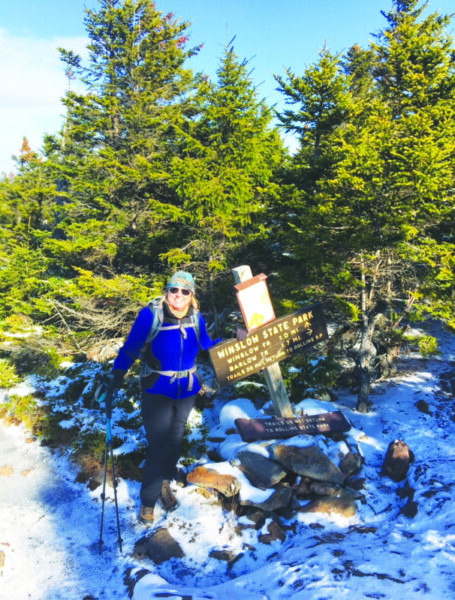
After clothing, Robertie will speak on staying secure in your footing.
“Traction is what keeps you from slipping. Some boots have deep lugs, so kind of the bumps on the bottom … But sometimes you need a little bit more, so I talked about things like microspikes, which are quarter-inch spikes on chains that are attached to a … rubber-type thing that you put on the toe of your boot and then draw it back and up around your heel. That holds the spikes in place underneath your foot. So the microspikes are good when there’s definitely ice and they are very grippy.”
Bigger spikes are needed for the mountains. “I didn’t go into crampons or anything like that because that’s more of a steeper mountain, mountaineering kind of traction…. That’s a big spike that’s maybe a 3- or 4-inch spike that, it’s not just one spike, it’s a series of spikes underneath your boot that provides a lot of traction and is meant for very steep and very icy trails.”
And sometimes a wide, flat surface is what is called for in the winter.
“I spoke about snowshoes as well, which typically don’t come into play too much on a rail trail because there’s so much foot traffic, but if you’re breaking ground in snow a snowshoe is going to help you stay buoyant on the snow instead of possibly falling in…. The rail trails are typically packed down, but after a snowstorm, if you’re the first one out, there’s definitely a possibility that you could be running into some deep snow.”
Trekking poles can help you stay upright. “Trekking poles are great for stability. If you’re older or even young people nowadays, it’s really great for staying stable on your trail. It helps you walk a little more briskly. And if you’re doing a water crossing, which typically you don’t do on a rail trail but you might do on one of the town trails. It’s great for descent and especially if you’ve got bad knees because it takes some of the pressure off your knees.”
Robertie also mentioned the benefits of the New Hampshire Fish and Game Hike Safe Card. “The Hike Safe, which is through the New Hampshire Fish and Game, is something that you can purchase to help support the Hampshire Fish and Game. It’s $25 for an individual, $35 for a family, and if you have that and have not been irresponsible, if it happens that you do need to be rescued, then you won’t be charged the rescue costs.”
She hopes to spread her enthusiasm about winter hiking to others.
“It’s all about getting outdoors. The fresh air, the health benefits of being in a forest are well documented and studied. We want people to do that and we want them to do it safely and more than anything to have fun and enjoy it. It’s a great resource. The more people out there, the better,” Robertie said.
Birds in winter
Grace McCulloch works for the New Hampshire Aubudon is excited to get more Granite Staters interested in a winter activity that pairs well with winter walks and hikes: birding.
“One of our favorite projects here at New Hampshire Audubon is the Backyard Winter Bird Survey, which this year is taking place on February 8th and 9th. It’s a weekend out of the year where we encourage people to report the birds that they see in their backyards to us at New Hampshire Audubon. The reporting form will be open for a few days after just so that everyone can get their results in,” McCulloch said.
The Survey has been going strong for decades. “This will be our 38th year doing the Backyard Winter Bird Survey,” she said, “and so over that time we’ve gathered a huge amount of data to really get an understanding of bird trends throughout the state. Being able to look through that kind of year-to-year variation and noise and see what bird species are increasing in number and what species might also be declining in the state.”
The process is simple. “The survey is really easy. We have a simple online survey form on our website where people report what they see over the weekend. They can watch for as little as 15 minutes, or if they’re really dedicated they can watch the entire weekend as well.”
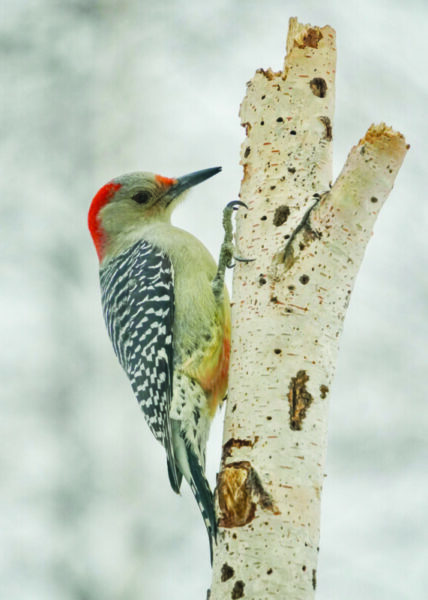
Birders do not need to be experts.
“We know that not everyone is out there birding every day, and that’s one of the things I love about the survey, is that it really is supposed to be easy for people who maybe this is the first time that they’re taking time to notice the birds in their backyard.”
The NH Audubon has plenty of helpful information on birds.
“We have a ton of resources on our websites, including a guide to the most common winter birds that people can check out, as well as a guide to commonly confused birds. Because there are species that can look quite similar. You can know that you have a woodpecker, but which woodpecker is it?”
The landscape of birds has changed in the state over the years. “You’d be surprised how dramatically the bird communities have shifted,” McCulloch said. “One example that I like to talk about a lot are American robins and eastern bluebirds. These are species that were once thought of as signs of spring. They arrived just in time for the beginning of spring. When we first started the survey in 1987 they were almost unheard of in February in the state. But today they’re frequently seen by people on the Backyard Winter Bird Survey in February. So just in 35 years, a huge shift.”
“We’re also seeing new species appear on the survey, species that are typically found further south. And … our work is even more important as we look to understand how bird species range and how long they’re staying in the winter might shift over time. We’re … seeing new species arrive, like red-bellied woodpeckers and Carolina wrens.”
Fan favorites will be making a return as well. “Our most common bird last year was the American goldfinch. We actually had about 10,000 of those reported on the survey. Then other favorite birds like black-capped chickadees, northern cardinals, those are always very distinct birds, easy to identify. We had a lot of blue jays on the survey last year, and also things like mourning doves.”
McCulloch said residents can take steps to entice birds to their homes. “I always encourage people if they want to put up a suet feeder. It’s kind of like a block of suet that you can put up and that really will help attract the woodpeckers. You can see several different woodpeckers just within one weekend. Things like downy woodpeckers, hairy woodpeckers and red-bellied woodpeckers, you can see all three in your backyard. The amazing thing is most of our feeder birds, multiple species, are all feeding together at once, so you have a good chance of seeing more than one species at a time.”
Now is the time to make your guesses on which birds will be showing up.
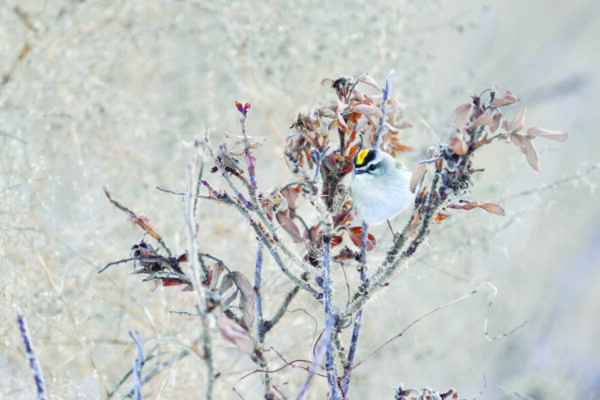
“Our senior biologist, Pam Hunt, always likes to make predictions for the survey. … this year, based on some food availability up north, we’re predicting a higher number of red-breasted nuthatches. … We’re also expecting a fairly good showing of species like red-bellied woodpeckers and Carolina wrens as our winters get warmer over time,” she said.
The Carolina wren has been drawing attention here, she said. “They’re a species that 10 years ago people weren’t seeing in the state, so when you see a brand new bird at your bird feeder, you’re like, ‘What is this bird?’”
“If you’re talking about hiking the 48 4,000-footers in winter, a bird you could always mention is the Canada jay or the gray jay,” McCulloch said. “That’s a bird that you typically only find on the top of mountains in New Hampshire, and you find it in the winter, and they love peanuts and other food that hikers bring them up. They’re known to eat out of hikers’ hands on the top of the snowy mountains,” she said.
Where to hike
Here are some ideas for finding winter (and all-season) hiking spots that match your skill level and interest.
• Renee Robertie suggested checking out rail trails. See nbrailtrail.com for information on the New Boston Rail Trails, including maps and a link to the group’s social media for updates on conditions. For information about rail trails throughout the state, check out the New Hampshire Rail Trails Coalition at nhrtc.org, which offers links to rail trail groups around the state and brief descriptions of the trails.
• The Society for the Protection of New Hampshire Forests offers a visitor’s guide that lets you filter through its properties for location, difficulty of trail and specific activity like snowshoeing or bird-watching. See forestsociety.org/visitor-guide.
• On the New Hampshire State Parks website, a specific guide to winter parks includes popular hiking parks as well as spots for snowshoeing, fat biking, ice fishing and mushing. See nhstateparks.org/things-to-do/winter-recreation.
• The New Hampshire Audubon (nhaudubon.org) will hold its annual Backyard Birding Survey Saturday, Feb. 8, and Sunday, Feb. 9. See the website for details. While you’re there, check out the information about their trails at sanctuaries near the Audubon’s centers including the Susan N. McLane Center in Concord and the Massabesic Audubon Center in Auburn as well as wildlife sanctuaries across the state. The sanctuaries page offers maps and guides to each property.
• Beaver Brook Association (117 Ridge Road in Hollis; beaverbrook.org) has 35+ miles of trails, according to the website, as well as ongoing fitness hikes that can get you started by letting you hike with a crowd.
• The state Division of Travel and Tourism Development describes 10 winter hike options including Mount Major, with its views of Lake Winnipesaukee; the ever-popular Mount Monadnock; and hiker favorite Mount Cardigan, “a very popular area for hiking and snowshoeing,” at visitnh.gov/blog/10-popular-winter-hikes.
• Picturesque local parks with trails are good places for winter strolls, usually not too hilly, such as Mine Falls Park in Nashua (nashuanh.gov/491/Mine-Falls-Park), Livingston Park and other city trails in Manchester (manchesternh.gov/Departments/Parks-and-Recreation/Parks-Trails-and-Facilities/Recreational-Trails), and several park trails in Concord (concordnh.gov/1033/Trails). According to the Concord trails website, there are three group hikes currently scheduled: On Saturday, Feb. 22, at 9:30 a.m., Bob Lyon will lead a 3-mile hike on Broken Ground trails; on Saturday, March 29, Peter Bartlett will lead a Morono Park trails hike, and on Saturday, April 26, at 9:30 a.m., Wendy Olson will lead a hike of the Winant Park trails.
Featured Image: Photo by Matt Larson.

